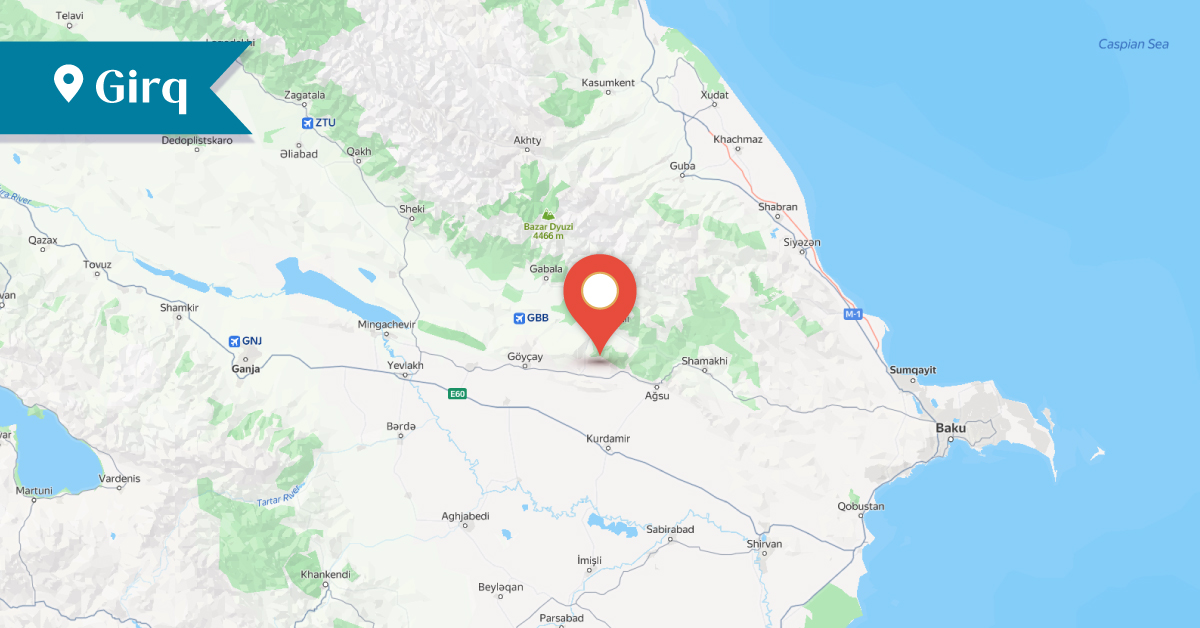2025
2025
2025-07-28

The village of Girq (also spelled Girk, Kirq) in the Ismayilli district is located 12.5 km southwest of the district center. It was one of the oldest and most populated settlements in the region. The residents had migrated from the villages of Qert, Togh, Gishi, Taghavard, Hatsi, Hghorti, Taghlar, and Nngi, as well as from the Jraberd region of Artsakh.
There are several stories regarding the origin of the village’s name. According to one version, the residents were quarrelsome and passionate by nature, which is why the village was also called Kirq. [1] Another version suggests that the name “Girq” was given due to the village’s location, as it is surrounded on all four sides by mountain ridges—“the village is embraced from all sides…”[2] The variant “Girq” has also been explained by the fact that the residents loved reading.
In 1861, the village had 130 Armenian households. During the visit of Bishop Makar Barkhudaryants in 1886, there were 227 Armenian households in the village, with a population of 1,282. According to data from 1914, Girq was entirely inhabited by Armenians, with a total 1,860 residents.
In August 1918, the village was attacked by Turkish forces and local Tatars. Between 1918 and 1920, it was raided several times by Turkish-Tatar military units and was nearly depopulated.
After the establishment of Soviet rule in Azerbaijan, survivors of the massacres returned to their native village. In 1924, Girq had 48 Armenian households and 144 residents. During the Soviet period, an eight-year school was opened in the village, with 40 students enrolled in 1984. The school was closed in 1988.
In 1985, Girq was home to 50 Armenian households, all of which were forcibly displaced by the end of 1988.
During the visit of monument specialist Samvel Karapetyan in 1985, the village still preserved the Church of Saint Paul-Peter, built in 1831. Its construction inscription read:
“This holy church was built in memory
of the three brothers from Girq—Petros, Poghos,
and Baghdasar, sons of Grigoryan Hovsep,
and their mother Aziz, in the year 1831.”
On the eastern side of the village, a cemetery contained numerous old style tombstones dating from the 15th to the 20th centuries, as recorded during Samvel Karapetyan’s visit. Approximately 600 of the stones dated to the 19th century. The oldest tombstone dated to the 15th century and bore the following inscription:
“Soghratmish, son of Ghapaypush,
in the year 1474.”
Another inscription copied from a 17th-century tombstone in the cemetery read:
“This tomb was made in 1653.
For the sake of God, pray for the soul of Shahverdi.”
The cemetery also preserved the gravestone of the village’s long-serving priest, Baghdasar Ter-Markosyants, which bore this inscription:
“This is the tomb of senior priest
Ter Baghdasar Markosyants, who served
in the priesthood for 47 years,
passed away on July 1,
in the year 1883, at the age of 73.”
Samvel Karapetyan also copied the inscription from the tombstone of a woman who had passed away at the age of 100. It read:
“This is the tomb of Mariam Ter-Markosyants,
who passed away at the age of 100,
on August 26, in the year 1890, in the village of Girq.”
An inscription was also found on the front stone of a spring constructed on the southern edge of the village:
“This spring is in memory of Agha
Petros and Moses Nersesyants,
1 September, year 1840."
Today, the village is known as Girq and is inhabited by Azerbaijanis.
Bibliography
Barkhutaryants M., Land of Aghvank and its Neighbors: Artsakh, Yerevan, 1999.
Karapetyan S., The Armenian Lapidary Inscriptions of Aghvank Proper, Yerevan, 1997.
Karapetyan, S., Aghvank Proper, Part 1, Yerevan, 2024, pp. 113-130
Aghbaleants, A. “Girq and Its Inhabitants.” Ardzaganq, no. 50, 1894.
[1] Aghbaleants, A. “Girq and Its Inhabitants.” Ardzaganq, no. 50 (May 4, 1894): p. 3.
[2] Ibid.